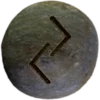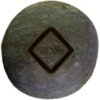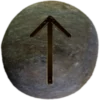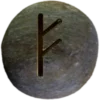Last Updated on March 15, 2025



Symbolism, Etymology, and Meaning
The Jēra (pronounced “YAY-rah”) rune represents cycles, harvest, and rewards for effort. It symbolizes natural rhythms and the passage of time. It has no reversed position, meaning its interpretation remains stable.
Jēra embodies the cyclical nature of life. It signifies patience, growth, and the eventual reward for persistence. This rune mirrors the changing seasons and the agricultural cycle. Farmers relied on these cycles to predict planting and harvesting periods.
The rune consists of two mirrored K-shaped lines. This shape reflects the interplay of opposing forces. Light and dark, growth and dormancy, action and rest—all exist within Jēra. It emphasizes balance and forward motion.
The Old Norse spelling is “Jāra.” The Proto-Germanic form is “Jēran.” Old English sources spell it “Gēar,” pronounced “YAY-ar.” This connects to the modern English word “year.” The word stems from Proto-Indo-European roots meaning “year” or “harvest.”
Historical Use and Context
Jēra appears in ancient inscriptions on tools, stones, and talismans. Its presence suggests a connection to agricultural rituals. Farmers and traders may have used the rune to mark successful harvests or fair exchanges.
Unlike other runes, it does not have direct ties to war or conflict. Instead, it relates to patience and effort. Ancient societies valued it for its connection to prosperity and foresight.
Mentions in Historical Texts
The Old English Rune Poem refers to “Gēar” as a symbol of abundance. It describes the joy of harvest and the rewards of toil.
A year brings joy, and the earth bears its fruits.
This passage highlights its association with patience and cyclic success.
Divinatory Meaning
Jēra represents fruition and natural progression. It reminds one that effort will bring results in due time. The rune signals positive outcomes but stresses patience. Unlike runes with immediate impact, it unfolds gradually.
In a reading, it suggests:
- Long-term success
- Hard work paying off
- Seasonal or cyclical changes
- Slow but steady progress
It rarely signifies sudden shifts. Instead, it reassures that persistence will yield benefits.
Magical and Practical Uses
Ancient practitioners used this rune in charms for prosperity. Some inscribed it on amulets to encourage fruitful endeavors. Farmers may have carved it onto plows or granaries as a blessing.
Modern practitioners see it as a rune of patience and planning. It serves as a reminder to trust the process.
Associated Deities and Mythological Ties
Jēra connects to deities linked with agriculture and cycles. In Norse tradition, Freyr governs harvests and fertility. His blessings align with its themes of prosperity and renewal.
While no Eddic poem directly mentions Jēra, its themes appear throughout Norse mythology. The Prose Edda describes how the gods control seasons and growth. These ideas align with its core symbolism. ![]()
Jēra in Modern Context
Today, Jēra remains relevant. It symbolizes long-term goals and steady effort. People associate it with personal growth, financial stability, and endurance.
Many incorporate it into:
- Meditation for patience
- Symbols for business ventures
- Artistic representations of cycles
This rune reminds individuals to embrace life’s natural flow. By understanding cycles, one can navigate challenges with wisdom.
Runes Associated with Jēra
Gebō (ᚷ) represents gifts, exchanges, and balance. It connects to Jēra’s themes of cycles and rewards for effort. The rune emphasizes partnerships, mutual benefit, and fairness. It reflects harvest cycles, Gebō highlights the importance of reciprocity in relationships and trade.
Ingwaz (ᛜ) symbolizes fertility, growth, and stored potential. It shares Jēra’s focus on natural rhythms and gradual progress. This rune often represents internal development and the release of accumulated energy when the time is right. Ingwaz embodies patience, preparation, and eventual reward.
Both Elder Futhark runes emphasize natural cycles. Gebō focuses on balance in human interactions, while Ingwaz represents internal and external transformation. Together, they complement Jēra’s message of steady progress leading to fruitful outcomes.
Its power in Asatru
Jēra represents cycles, harvest, and rewards for hard work. Asatruar see it as a sign of patience and perseverance. It reminds them that effort brings results in time.
This rune connects to the natural order, reinforcing the idea of Wyrd and the turning of seasons. Many Asatruar honor it during harvest celebrations, recognizing the gifts of the land. It symbolizes justice, balance, and earned success.
Jēra also teaches that growth happens through steady action, not haste. Asatruar use it to mark personal achievements and long-term goals. Some see it as a sign of hope during struggles, knowing change will come. This rune does not promise instant rewards, but it assures that diligence leads to fulfillment.


